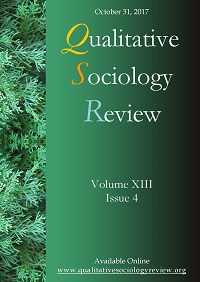Experiencing a Call to Ministry: Changing Trajectories, Re-Structuring Life Stories
DOI:
https://doi.org/10.18778/1733-8077.13.4.02Keywords:
Identity, Narrative Work, Turning Points, Christian Ministry, GenderAbstract
This paper presents a qualitative analysis of women’s experiences of call to Christian pastoral ministry as a second career—a mid-life turning point. Drawing on 44 semi-structured interviews with pastors of different denominations, I look at women’s stories of call through the lens of interpretive theory to analyze how women create meanings around this life altering event, and how they construct past experiences in light of these decisions. I employ George Herbert Mead’s theory of time to analyze how women afford prior secular work experiences sacred meaning in light of their subsequent “pastoral call” experience. This paper attempts to arrive at a better understanding of women’s experience of entering pastoral ministry, as well as their past and future life trajectories.
Downloads
References
Adams, Jimi. 2007. “Stained Glass Makes the Ceiling Visible: Organizational Opposition to Women in Congregational Leadership.” Gender and Society 21(1):80-105.
Google Scholar
DOI: https://doi.org/10.1177/0891243206293773
Bond, Adam L. 2012. I’ve Been Called: Now What? King of Prussia, PA: Judson Press.
Google Scholar
Chang, Patricia M. Y. 1997. “Introduction to Symposium: Female Clergy in the Contemporary Protestant Church: A Current Assessment.” Journal for the Scientific Study of Religion 36(4):565-573.
Google Scholar
DOI: https://doi.org/10.2307/1387690
Charmaz, Kathy. 2014. Constructing Grounded Theory: A Practical Guide Through Qualitative Analysis. Los Angeles: Sage.
Google Scholar
Chaves, Mark. 1996. “Ordaining Women: The Diffusion of an Organizational Innovation.” American Journal of Sociology 101(4):840-873.
Google Scholar
DOI: https://doi.org/10.1086/230782
Christopherson, Richard W. 1994. “Calling and Career in Christian Ministry.” Review of Religious Research 35(3):219-237.
Google Scholar
DOI: https://doi.org/10.2307/3511890
Cloward, Richard A. 1959. “Illegitimate Means, Anomie, and Deviant Behavior.” American Sociological Review 24(2): 164-176.
Google Scholar
DOI: https://doi.org/10.2307/2089427
Cooley, Charles Horton. 1922. Human Nature and the Social Order. New York: Charles Scribners Sons.
Google Scholar
Doucet, Andrea. 2008. “‘From Her Side of the Gossamer Wall(s)’: Reflexivity and Relational Knowing.” Qualitative Sociology 31(1):73-87.
Google Scholar
DOI: https://doi.org/10.1007/s11133-007-9090-9
Duffy, Ryan and Bryan Dik. 2013. “Research on Calling: What Have We Learned and Where Are We Going? Journal of Vocational Behaviour 83(3):428-436.
Google Scholar
DOI: https://doi.org/10.1016/j.jvb.2013.06.006
Dunn, Jennifer L. and S. J. Creek. 2015. “Identity Dilemmas: Toward a More Situated Understanding.” Symbolic Interaction 38(2):261-284.
Google Scholar
DOI: https://doi.org/10.1002/symb.146
Durkheim, Emile. 1897. Suicide: A Study in Sociology. New York: Free Press.
Google Scholar
Galtung, Johan. 1996. “On the Social Costs of Modernization. Social Disintegration, Atomie/Anomie and Social Development.” Development and Change 27(2):379-413.
Google Scholar
DOI: https://doi.org/10.1111/j.1467-7660.1996.tb00596.x
George, James M. 2005. “The Call to Pastoral Ministry.” Pp. 81-91 in Pastoral Ministry: How to Shepherd Biblically, edited by John MacArthur. Nashville: Thomas Nelson.
Google Scholar
Goffman, Erving. 1958. The Presentation of Self in Everyday Life. Edinburgh: University of Edinburgh, Social Sciences Research Centre.
Google Scholar
Luhrmann, Tanya. 2012. When God Talks Back: Understanding the American Evangelical Relationship with God. New York: Vintage Books.
Google Scholar
DOI: https://doi.org/10.24260/alalbab.v1i1.16
Lummis, Adair T. and Paula D. Nesbitt. 2000. “Women Clergy Research and the Sociology of Religion.” Sociology of Religion 61(4):443-453.
Google Scholar
DOI: https://doi.org/10.2307/3712528
Mains, David R., Noreen M. Sugrue, and Michael A. Katovich. 1983. “The Sociological Import of G. H. Mead’s Theory of the Past.” American Sociological Review 48:161-173.
Google Scholar
DOI: https://doi.org/10.2307/2095102
Mead, George Herbert. 1929. “The Nature of the Past.” Pp. 235-42 in Essays in Honor of John Dewey, edited by John Coss. New York: Henry Holt.
Google Scholar
Mead, George Herbert. 1934. Mind, Self, and Society. Chicago: University of Chicago Press.
Google Scholar
Merton, Robert. 1957. Social Theory and Social Structure. New York: Free Press.
Google Scholar
Oden, Thomas C. 1987. Becoming a Minister. New York: Crossroad.
Google Scholar
Pitt, Richard N. 2012. Divine Callings: Understanding the Call to Ministry in Black Pentecostalism. New York: New York University Press.
Google Scholar
DOI: https://doi.org/10.18574/nyu/9780814768235.001.0001
Prus, Robert. 1996. Symbolic Interaction and Ethnographic Research. Albany: State University of New York Press.
Google Scholar
Prus, Robert. 1997. Subcultural Mosaics and Intersubjective Realities. Albany: State University of New York Press.
Google Scholar
Rose Fuchs Ebaugh, Helen. 1988. Becoming an Ex: The Process of Role Exit. Chicago: University of Chicago Press.
Google Scholar
DOI: https://doi.org/10.7208/chicago/9780226160535.001.0001
Rosenbaum, Mark S. and Ronald Kuntze. 2003. “The Relationship Between Anomie and Unethical Retail Disposition.” Psychology and Marketing 20(12):1067-1093.
Google Scholar
DOI: https://doi.org/10.1002/mar.10109
Somers, Margaret. 1994. “Narrative and the Constitution of Identity: A Relational and Network Approach.” Theory and Society 23:605-649.
Google Scholar
DOI: https://doi.org/10.1007/BF00992905
Stewart-Thomas, Michelle. 2010. “Gendered Congregations, Gendered Service: The Impact of Clergy Gender on Congregational Social Service Participation.” Gender, Work and Organization 17(4):406-428.
Google Scholar
DOI: https://doi.org/10.1111/j.1468-0432.2009.00484.x
Stone, Gregory P. 1990. “Appearance and the Self.” Pp. 141-162 in Life as Theatre: A Dramaturgical Source Book, edited by Dennis Brissett and Charles Edgley. New Jersey: Transaction Publishers.
Google Scholar
Strauss, Anselm. 1959. Mirrors and Masks: The Search for Identity. Glencoe: The Free Press.
Google Scholar
Sullins, Donald Paul. 2000. “The Stained Glass Ceiling: Career Attainment for Women Clergy.” Sociology of Religion 61(3):243-266.
Google Scholar
DOI: https://doi.org/10.2307/3712578
Van den Hoonaard, Deborah Kestin. 2001. The Widowed Self: The Older Woman’s Journey through Widowhood. Waterloo: Wilfrid Laurier University Press.
Google Scholar
Zikmund, Barbara Brown, Adair T. Lummis, and Patricia M. Y. Chang. 1998. Clergy Women: An Uphill Calling. Louisville, KY: Westminster John Knox Press.
Google Scholar
Downloads
Published
How to Cite
Issue
Section
License

This work is licensed under a Creative Commons Attribution-NonCommercial-NoDerivatives 4.0 International License.











